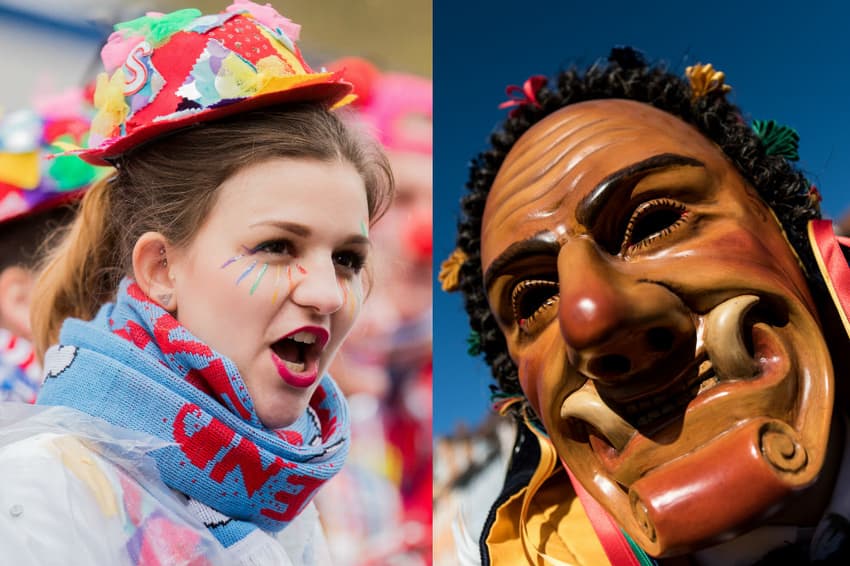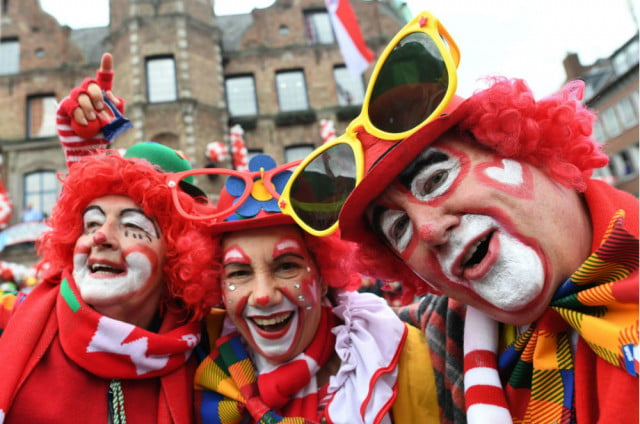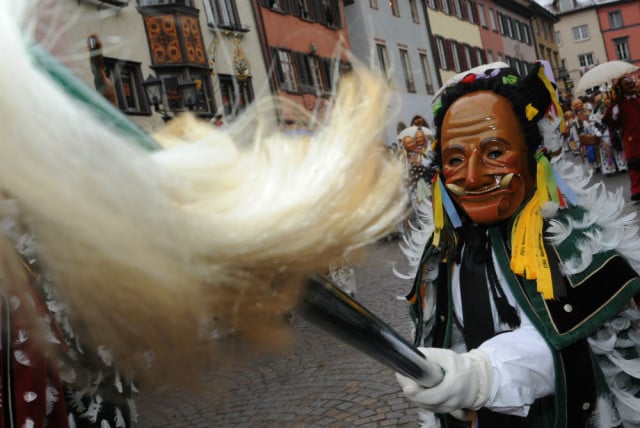Inflated pigs’ bladders vs. jesters: the difference between Fastnacht and Karneval

With Karneval festivities in Cologne and across the Rhineland fast approaching, another festival - Fastnacht - will also soon take place in the south of Germany. Here’s how the two traditions compare.
Large parts of the country come to a standstill for carnival in the days leading up to Lent in February.
In the Rhine region, the biggest carnival celebrations can be found in Cologne, with essential festivities taking place from February 8th to 14th. But Karnevale - complete with parades, floats and costumed revellers - also take place in cities like Aachen, Düsseldorf and Mainz.
Down in the Swabian region in southern Germany, as well as in parts of Switzerland and western Austria, a more serious tradition called Fastnacht, which distinguishes itself from the Rhenish carnival also bursts out in February.
Both traditions - Karneval and the Swabian-Alemannic Fastnacht - may seem similar, but they have their own individual peculiarities.
READ ALSO: 7 events across Germany you won't want to miss this February
Häs or Häschen?
For a Swabian Narr (Fool), the Häs, or costume worn during Fastnacht, is often based on designs that date back centuries. Costumes are also crafted by hand and can cost several thousand euros. Many wear a Häs that has been handed down through the generations.
In the southwest region of Germany, it’s an all-round more serious affair compared to carnivals further to the north. Some of the oldest processions take place in Villingen, Oberndorf and Elzach.
People in the town of Rottweil in the Black Forest have a custom of polishing their hand-carved wooden masks for the Narrensprung (Fools’ Leap) procession - to take place this year on February 12th and 13th.
Fastnacht also has a more sinister and medieval feel to it in the Baden-Württemberg town, with grotesquely-masked witches scaring children and some adults.
 Festival-goers at the Karneval parade last year in Düsseldorf. Photo: DPA
Festival-goers at the Karneval parade last year in Düsseldorf. Photo: DPA
Meanwhile revellers in the Rhineland are more likely to be dressed up as cowboys, clowns or Häschen (bunny rabbits). Hardcore festival-goers often opt to make their own costume instead of buying one.
Sweet or savoury?
Whereas sweets are thrown into the crowds during the parades that take place at Karneval, Swabian Fools prefer savoury dishes.
Baden-Württemberg's minister president Winfried Kretschmann, for example, enjoys eating a traditional dish called Froschkutteln (frog tripe) at Fastnacht. But before you judge too quickly, despite its name, the dish is actually made with beef and not frogs.
A kiss or a… calf’s tail?
At Karneval, a festival of excess with lots of booze and love to go around, anyone who attends should expect to be kissed on the cheeks by total strangers at least once. Even public officials have to put up with being greeted this way; to reject them is seen as rude.
 A Federahannes carrying a pole in Rottweil, Baden-Württemberg. Photo: DPA
A Federahannes carrying a pole in Rottweil, Baden-Württemberg. Photo: DPA
But in Rottweil, a tradition that’s arguably even more unusual takes place, when Federahannes - Fools who have large teeth curving out of their mouth and costumes covered in goose feathers - rush at spectators carrying a long pole. Attached to the pole is a heavily perfumed calf's tail which the Fool dangles in people's faces while growling and purring.
At some Fastnacht processions, young women are also teased in the face with a Saublodere (the inflated bladder of a pig) or a Farrenschwanz (an oxtail).
Humour or… none at all?
Carnival has various origins, stemming from the Roman tradition of celebrating the start of spring and ancient Germanic fertility rites. Christians adopted the traditions as a way to usher in the fasting period before Easter.
It’s also seen as an opportunity to poke fun at the authorities, as reflected in satirical floats at the big carnival processions in the Rhineland.
Some Rhineland carnival societies have colourful 19th-century military outfits that were designed to poke fun at the French and the Prussian authorities who at various points in history had the audacity to ban carnival out of fear that the revellers might be plotting sedition behind their masks.
Last year a float at the Düsseldorf parade depicted the American President Donald Trump apparently raping the Statue of Liberty.
But this kind of humour is suspect for Swabian revellers, according to carnival expert and author Wolfgang Oelsne.
At Fastnacht the “humour is more subtle and less arbitrary," Oelsne said.
READ ALSO: 10 words you need to know before Cologne Carnival
Comments
See Also
Large parts of the country come to a standstill for carnival in the days leading up to Lent in February.
In the Rhine region, the biggest carnival celebrations can be found in Cologne, with essential festivities taking place from February 8th to 14th. But Karnevale - complete with parades, floats and costumed revellers - also take place in cities like Aachen, Düsseldorf and Mainz.
Down in the Swabian region in southern Germany, as well as in parts of Switzerland and western Austria, a more serious tradition called Fastnacht, which distinguishes itself from the Rhenish carnival also bursts out in February.
Both traditions - Karneval and the Swabian-Alemannic Fastnacht - may seem similar, but they have their own individual peculiarities.
READ ALSO: 7 events across Germany you won't want to miss this February
Häs or Häschen?
For a Swabian Narr (Fool), the Häs, or costume worn during Fastnacht, is often based on designs that date back centuries. Costumes are also crafted by hand and can cost several thousand euros. Many wear a Häs that has been handed down through the generations.
In the southwest region of Germany, it’s an all-round more serious affair compared to carnivals further to the north. Some of the oldest processions take place in Villingen, Oberndorf and Elzach.
People in the town of Rottweil in the Black Forest have a custom of polishing their hand-carved wooden masks for the Narrensprung (Fools’ Leap) procession - to take place this year on February 12th and 13th.
Fastnacht also has a more sinister and medieval feel to it in the Baden-Württemberg town, with grotesquely-masked witches scaring children and some adults.
 Festival-goers at the Karneval parade last year in Düsseldorf. Photo: DPA
Festival-goers at the Karneval parade last year in Düsseldorf. Photo: DPA
Meanwhile revellers in the Rhineland are more likely to be dressed up as cowboys, clowns or Häschen (bunny rabbits). Hardcore festival-goers often opt to make their own costume instead of buying one.
Sweet or savoury?
Whereas sweets are thrown into the crowds during the parades that take place at Karneval, Swabian Fools prefer savoury dishes.
Baden-Württemberg's minister president Winfried Kretschmann, for example, enjoys eating a traditional dish called Froschkutteln (frog tripe) at Fastnacht. But before you judge too quickly, despite its name, the dish is actually made with beef and not frogs.
A kiss or a… calf’s tail?
At Karneval, a festival of excess with lots of booze and love to go around, anyone who attends should expect to be kissed on the cheeks by total strangers at least once. Even public officials have to put up with being greeted this way; to reject them is seen as rude.
 A Federahannes carrying a pole in Rottweil, Baden-Württemberg. Photo: DPA
A Federahannes carrying a pole in Rottweil, Baden-Württemberg. Photo: DPA
But in Rottweil, a tradition that’s arguably even more unusual takes place, when Federahannes - Fools who have large teeth curving out of their mouth and costumes covered in goose feathers - rush at spectators carrying a long pole. Attached to the pole is a heavily perfumed calf's tail which the Fool dangles in people's faces while growling and purring.
At some Fastnacht processions, young women are also teased in the face with a Saublodere (the inflated bladder of a pig) or a Farrenschwanz (an oxtail).
Humour or… none at all?
Carnival has various origins, stemming from the Roman tradition of celebrating the start of spring and ancient Germanic fertility rites. Christians adopted the traditions as a way to usher in the fasting period before Easter.
It’s also seen as an opportunity to poke fun at the authorities, as reflected in satirical floats at the big carnival processions in the Rhineland.
Some Rhineland carnival societies have colourful 19th-century military outfits that were designed to poke fun at the French and the Prussian authorities who at various points in history had the audacity to ban carnival out of fear that the revellers might be plotting sedition behind their masks.
Last year a float at the Düsseldorf parade depicted the American President Donald Trump apparently raping the Statue of Liberty.
But this kind of humour is suspect for Swabian revellers, according to carnival expert and author Wolfgang Oelsne.
At Fastnacht the “humour is more subtle and less arbitrary," Oelsne said.
READ ALSO: 10 words you need to know before Cologne Carnival
Join the conversation in our comments section below. Share your own views and experience and if you have a question or suggestion for our journalists then email us at [email protected].
Please keep comments civil, constructive and on topic – and make sure to read our terms of use before getting involved.
Please log in here to leave a comment.